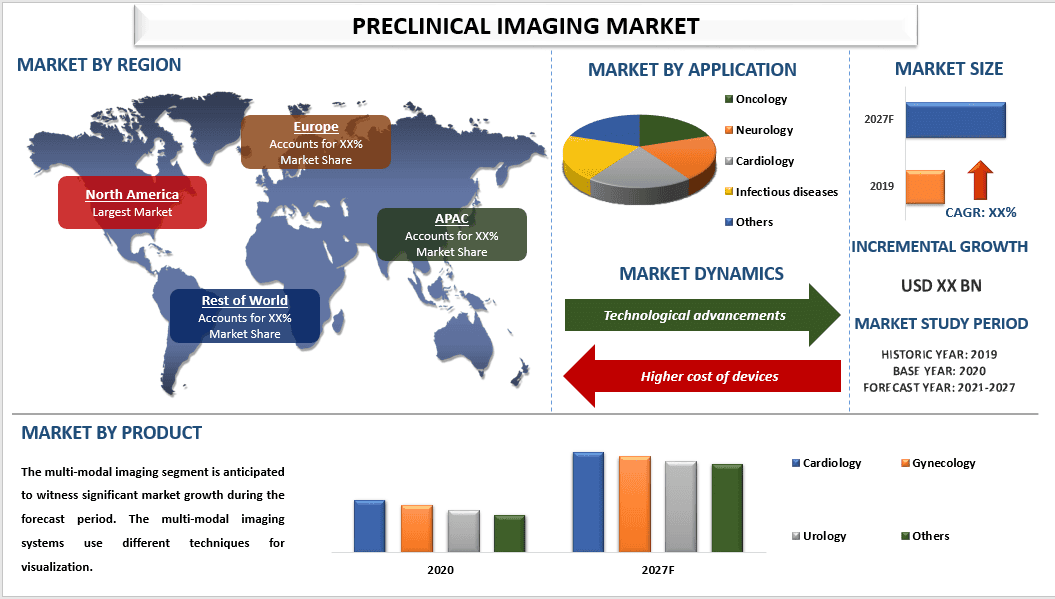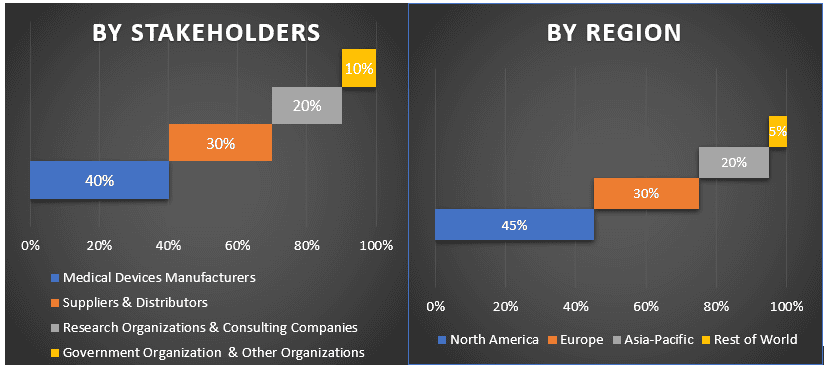- Home
- About Us
- Industry
- Services
- Reading
- Contact Us
Preclinical Imaging Market: Current Analysis and Forecast (2021-2027)
Emphasis on Product (CT imaging, MRI imaging, PET/SPECT imaging, Multi-Modal Imaging, Optical Imaging, Ultrasound Imaging, Photoacoustic Imaging, Reagents, and Services.); Application (Oncology, Neurology, Cardiology, Infectious Diseases, and Others); Region/Country

The Global Preclinical Imaging Market is anticipated to grow with an elevated CAGR of around 5% over the forecast period (2021-2027). Preclinical imaging is the visualization of living animals for research purposes, such as drug development. Researchers use imaging to observe changes, at the organ, tissue, cell, or molecular level, in animals’ response to physiological or environmental changes.
The rising prevalence of chronic diseases and the increasing geriatric population are the contributing factors to the increasing demand for the research & development of the new drugs. Furthermore, the surging incidences of genetic and orphan diseases rise the demand for the development of the novel treatment which results in the growth of the preclinical imaging market. For instance, as per the Health department of Australia, Approximately 6 out of 10 people will be affected by a condition that has some genetic background. Genetic conditions can range from mild to very severe. Genetic conditions and birth defects occur in between 3 and 5 percent of babies born in Western Australia.
Bruker Corporation, Siemens A.G., General Electric (GE), TriFoil Imaging, PerkinElmer, Inc., VisualSonics Inc. (Fujifilm), Mediso Ltd., Agilent Technologies, MILabs B.V., and MR solutions. Several M&As along with partnerships have been undertaken by these players to facilitate customers with new varieties of Preclinical Imaging.
Insights Presented in the Report
“Amongst product, multi-modal imaging holds the major share”
Based on the product, the market is segmented into CT imaging, MRI imaging, PET/SPECT imaging, multi-modal imaging, optical imaging, ultrasound imaging, photoacoustic imaging, reagents, and services. The multi-modal imaging held a significant market share and is anticipated to witness significant growth during the forecast period. The increasing adoption of multimodal imaging because these systems use different imaging techniques for disease analysis is one of the factors that positively affects the market for preclinical imaging. Furthermore, the rising demand from government institutions for the research also increases the market for multi-modal imaging. For instance, in November 2021, the Union Minister of State (Independent Charge) for the Ministry of Science and Technology, Dr. Jitendra Singh inaugurated the project SWADESH. The project SWADESH is the first-of-its-kind large-scale multimodal neuroimaging database designed specifically for the Indian population.
“Amongst application, cardiology holds the major share”
Based on application, the market is segmented into oncology, neurology, cardiology, infectious diseases, and others. the cardiology segment is expected to witness lucrative growth during the forecast period. This is mainly due to the rapidly increasing cases of heart disease owing to the segmental growth of cardiology in the preclinical imaging market. For instance, One person dies every 36 seconds in the United States from cardiovascular disease. About 659,000 people in the United States die from heart disease each year—that’s 1 in every 4 deaths.
“North America represents one of the largest markets of Preclinical Imaging market”
For a better understanding of the market dynamics of the Preclinical Imaging market, a detailed analysis was conducted for different regions across the globe including North America (U.S, Canada, and the Rest of North America), Europe (Germany, France, Spain, United Kingdom, Italy, and Rest of Europe), Asia-Pacific (China, India, Australia, Japan, and Rest of APAC), Rest of World has been conducted. In 2020, North America grabbed a significant market share of the global market. It is expected to grow with considerable CAGR during the forecast period (2021-2027F). The major factors such as the presence of well-established research infrastructure and major market players along with frequent product launches are responsible for the regional growth in the preclinical imaging market. For instance, in May 2022, Bruker announced the launch of 7 Tesla and 9.4 Tesla conduction-cooled Maxwell magnets for its market-leading preclinical magnetic resonance imaging (MRI) systems portfolio. The Maxwell 7 Tesla and 9.4 Tesla magnets eliminate the need for liquid helium or nitrogen refills while offering high-field sensitivity and resolution for advanced preclinical MRI and PET/MR research.
Reasons to buy this report:
- The study includes market sizing and forecasting analysis validated by authenticated key industry experts
- The report presents a quick review of overall industry performance at one glance
- The report covers an in-depth analysis of prominent industry peers with a primary focus on key business financials, product portfolio, expansion strategies, and recent developments
- Detailed examination of drivers, restraints, key trends, and opportunities prevailing in the industry
- The study comprehensively covers the market across different segments
- Deep dive regional level analysis of the industry
Customization Options:
The global preclinical imaging market can further be customized as per the requirement or any other market segment. Besides this, UMI understands that you may have your own business needs, hence feel free to connect with us to get a report that completely suits your requirements.
Table of Content
Research Methodology for the Global Preclinical Imaging Market Analysis (2021-2027)
Analyzing the historical market, estimating of the current market, and forecasting the future market of the global preclinical imaging market were the three major steps undertaken to create and analyze the adoption of preclinical imaging in major regions globally. Exhaustive secondary research was conducted to collect the historical market numbers and estimate the current market size. Secondly, to validate these insights, numerous findings and assumptions were taken into consideration. Moreover, exhaustive primary interviews were also conducted, with industry experts across the value chain of the global preclinical imaging market. Post assumption and validation of market numbers through primary interviews, we employed a top-down/bottom-up approach to forecasting the complete market size. Thereafter, market breakdown and data triangulation methods were adopted to estimate and analyze the market size of segments and sub-segments the industry pertains to. Detailed methodology is explained below:
Analysis of Historical Market Size
Step 1: In-Depth Study of Secondary Sources:
Detail secondary study was conducted to obtain the historical market size of the preclinical imaging through company internal sources such as annual report & financial statements, performance presentations, press releases, etc., and external sources including journals, news & articles, government publications, competitor publications, sector reports, third-party database, and other credible publications.
Step 2: Market Segmentation:
After obtaining the historical market size of the preclinical imaging market, we conducted a detailed secondary analysis to gather historical market insights and share for different segments & sub-segments for major regions. Major segments included in the report as products and applications. Further country-level analyses were conducted to evaluate the overall adoption of Preclinical Imaging across the globe.
Step 3: Factor Analysis:
After acquiring the historical market size of different segments and sub-segments, we conducted a detailed factor analysis to estimate the current market size of preclinical imaging. Further, we conducted factor analysis using dependent and independent variables such as the growing number of people with chronic diseases and the increasing elderly population all over the globe. A thorough analysis was conducted for demand and supply-side scenarios considering top partnerships, mergers and acquisitions, business expansion, and product launches in the Preclinical Imaging sector across the globe.
Current Market Size Estimate & Forecast
Current Market Sizing: Based on actionable insights from the above 3 steps, we arrived at the current market size, key players in the Preclinical Imaging market, and market shares of the segments. All the required percentage shares split, and market breakdowns were determined using the above-mentioned secondary approach and were verified through primary interviews.
Estimation & Forecasting: For market estimation and forecast, weights were assigned to different factors including drivers & trends, restraints, and opportunities available for the stakeholders. After analyzing these factors, relevant forecasting techniques i.e., top-down/bottom-up approach were applied to arrive at the market forecast about 2027 for different segments and subsegments across the major markets globally. The research methodology adopted to estimate the market size encompasses:
- The industry’s market size, in terms of value (US$) and the adoption rate of Preclinical Imaging across the major markets domestically
- All percentage shares, splits, and breakdowns of market segments and sub-segments
- Key players in the preclinical imaging market in terms of products offered. Also, the growth strategies adopted by these players to compete in the fast-growing market
Market Size and Share Validation
Primary Research: In-depth interviews were conducted with the Key Opinion Leaders (KOLs) including Top Level Executives (CXO/VPs, Sales Head, Marketing Head, Operational Head, Regional Head, Country Head, etc.) across major regions. Primary research findings were then summarized, and statistical analysis was performed to prove the stated hypothesis. Inputs from primary research were consolidated with secondary findings, hence turning information into actionable insights.
Split of Primary Participants in Different Regions

Market Engineering
Data triangulation technique was employed to complete the overall market estimation and to arrive at precise statistical numbers for each segment and sub-segment of the preclinical imaging market. Data was split into several segments & sub-segments post studying various parameters and trends in the areas of product and applications of the preclinical imaging market.
The main objective of the Preclinical Imaging market study
The current & future market trends of preclinical imaging were pinpointed in the study. Investors can gain strategic insights to base their discretion for investments on the qualitative and quantitative analysis performed in the study. Current and future market trends determined the overall attractiveness of the market at a regional level, providing a platform for the industrial participant to exploit the untapped market to benefit as a first-mover advantage. Other quantitative goals of the studies include:
- Analyze the current and forecast market size of preclinical imaging in terms of value (US$). Also, analyze the current and forecast market size of different segments and sub-segments
- Segments in the study include areas of products and application
- Define and analysis of the regulatory framework for the preclinical imaging industry
- Analyze the value chain involved with the presence of various intermediaries, along with analyzing customer and competitor behaviors of the industry
- Analyze the current and forecast market size of the preclinical imaging market for the major region
- Major regions studied in the report include North America, Europe, Asia-Pacific and Rest of the world
- Company profiles of the preclinical imaging market and the growth strategies adopted by the market players to sustain in the fast-growing market
- Deep dive regional level analysis of the industry
Related Reports
Customers who bought this item also bought










